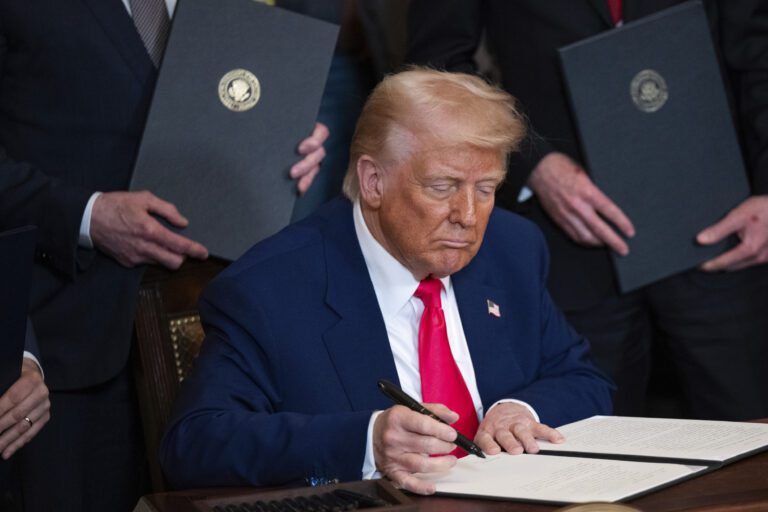Markets staged a sharp rebound on Thursday after US President Donald Trump unexpectedly announced a 90-day suspension of newly imposed tariffs on dozens of countries. The move, which followed a turbulent market rout earlier this week, brought temporary relief to global equities and bonds. However, US stock futures and the dollar struggled to join the rally, reflecting deeper investor unease.
The surprise reversal, coming just one day after Trump introduced sweeping tariffs, momentarily halted a downward spiral that had wiped out trillions in global market value. It also eased pressure on US Treasury bonds, where yields had surged amid widespread selling.
Global Stocks Rally, But US Assets Lag Behind
Asian markets responded with optimism. Japan’s Nikkei jumped 8%, and Hong Kong’s Hang Seng rose 2.2%. China’s CSI300 blue-chip index climbed 1%. European futures also surged, with the EUROSTOXX 50 and DAX both up around 8%, while FTSE futures gained 5.4%.
Despite the upbeat sentiment abroad, Nasdaq futures dropped more than 1%, and S&P 500 futures slid 0.75% in early Thursday trading. This pullback followed the biggest daily gains in over a decade for both indexes during Wednesday’s US cash session.
Currency markets echoed the mixed sentiment. The dollar fell 0.7% against the yen and 0.6% against the Swiss franc, failing to hold onto Wednesday night’s rebound against safe-haven currencies.
“The world, political and financial, is looking on with horror—not bemusement—at an administration that prioritises a water-pressure executive order on the same day the bond market breaks,” said Martin Whetton, Head of Financial Markets Strategy at Westpac.
China Tensions Persist Despite Temporary Relief
Although the 90-day pause offered global markets breathing space, it did not include previously enacted duties on autos, steel, and aluminium. A 10% blanket tariff on nearly all US imports also remains intact, confirmed the White House.
Notably, Trump increased tariffs on Chinese goods to 125%, up from Wednesday’s 104%. In retaliation, China raised its duties on US goods to 84% and imposed new restrictions on 18 US firms, primarily in the defense sector.
Despite the escalation, market participants focused on the temporary pause. Wong Kok Hoong, Head of Equity Sales Trading at Maybank, noted that the reprieve offers companies time to adapt:
“With 10% tariffs holding for 90 days, companies and businesses now have time—and options—to adjust. The China-plus-one supply chain route is still intact.”
Still, underlying caution remained. The onshore Chinese yuan fell to 7.3518 per dollar, marking its lowest level since December 2007. Before trading began, the People’s Bank of China set its midpoint rate at its lowest since September 2023.
Bond Market Stabilizes After Record Selloff
Thursday also saw signs of recovery in the bond market. US 10-year Treasury yields dropped to 4.2774%, down from a 4.5150% high in the previous session. The earlier selloff, sparked by inflation fears and trade turmoil, had echoed the COVID-era “dash for cash.”
Analysts pointed to multiple factors behind the pressure on bonds:
“Sticky inflation, a patient Fed, hedge fund deleveraging, and rebalancing from bonds into cash all contribute to the rising yields,” said Lawrence Gillum, Chief Fixed Income Strategist at LPL Financial.
The Federal Reserve’s March meeting minutes, released Wednesday, revealed caution toward rate cuts. While policymakers expressed concern over Trump’s trade policy impact, they still expect tariff-driven inflation to persist. As a result, market expectations for 2025 interest rate cuts have dropped to 80 basis points, down from over 100 earlier in the week.
Meanwhile, gold continued its climb, rising 1.5% to $3,128.92 per ounce, as investors sought refuge from financial volatility. Oil prices fell, reflecting concerns over the escalating trade conflict between Washington and Beijing.
Conclusion
While Trump’s decision to pause tariffs provided a brief window of relief, lingering trade tensions, currency instability, and bond market fragility suggest global investors are far from reassured. Markets will now watch closely to see whether this temporary reprieve signals a strategic shift—or merely delays the next escalation in global trade uncertainty.


